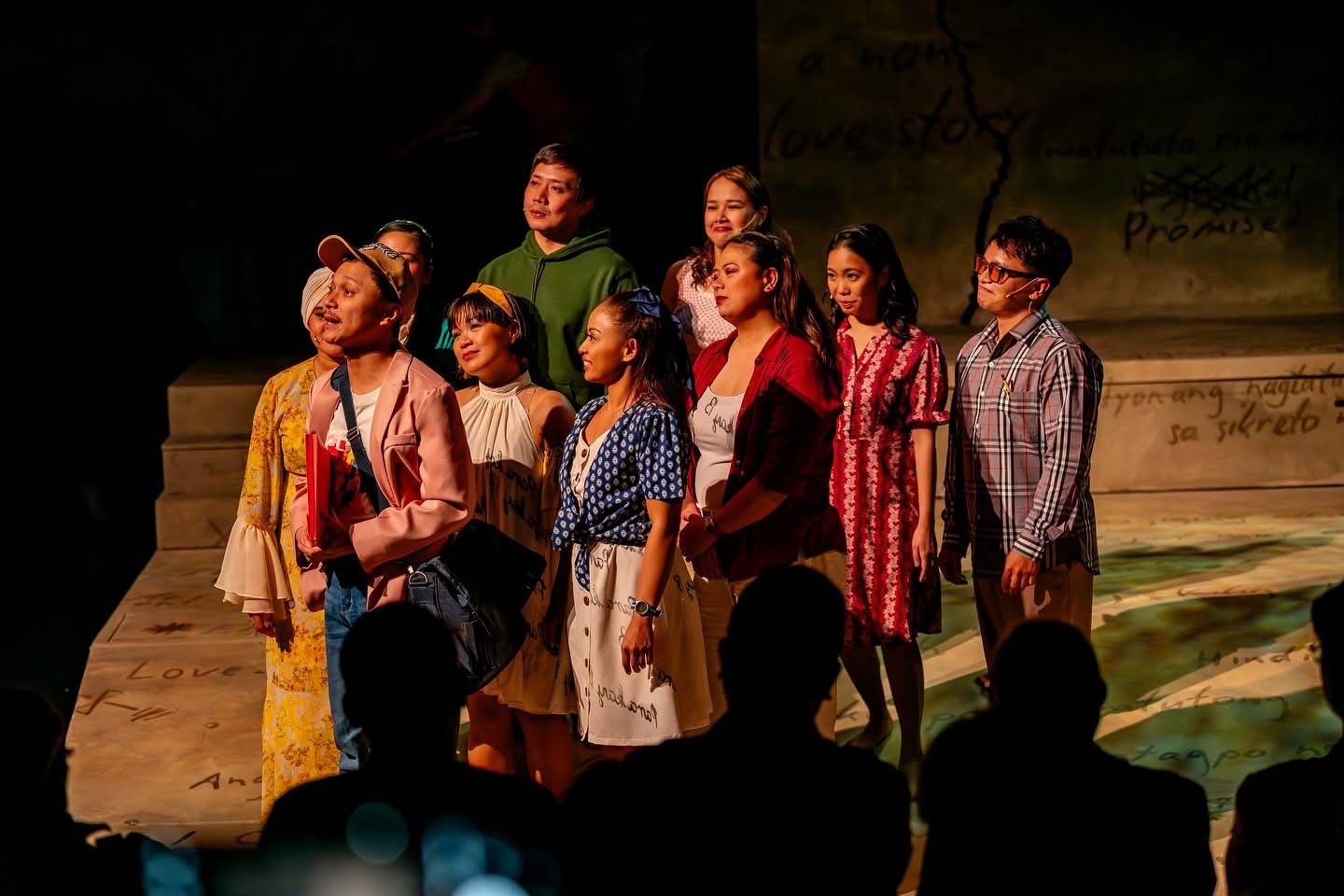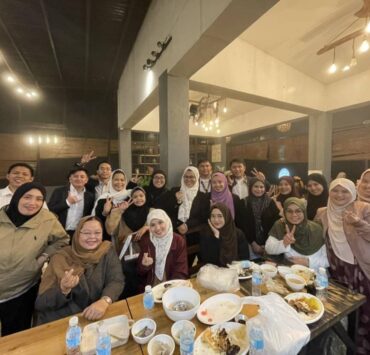A portrait of flawed, fragile love

There are many ways to watch “Para Kay B: A Stage Adaptation”—as a longtime fan of the author’s bestselling novel, as a theatergoer curious about how five love stories can cohere into a single-stage experience, or as an aspiring writer watching their craft reflected back at them. And depending on which lens you choose, the experience will hit differently. Loudly so.
For longtime readers, there’s a visceral thrill in seeing the characters you first met in your teenage years finally materialize onstage. For first-timers, there’s the delight of discovery. I came to this production through the second and third lenses: as an audience member and as a playwright-in-waiting.
The source material’s reputation precedes it—and with good reason. Penned in 2008 by National Artist for Film and Broadcast Arts Ricky Lee, “Para Kay B” marked a milestone in an already illustrious career. It wasn’t so much a departure from screenwriting as it was another feather in the cap of a living legend. The novel became a cult favorite and a touchstone for aspiring storytellers. This makes adapting it for the stage feel like summiting a beloved literary mountain, sacred to a generation of readers—and in this iteration, the production rises in most areas, though not without stumbles.
The story is layered, a narrative within a narrative. At its center is Lucas, a struggling writer who proposes a theory—that out of every five people who fall in love, only one will find happiness. “May quota ang pag-ibig,” the play insists.
To prove it, he writes five stories collectively dedicated to “B,” each one centered on a woman: Irene, Sandra, Erica, Ester, and Bessie. Together, they form a portrait of love in its most fragile, flawed forms.
Vignettes
These stories unfold as theatrical vignettes—distinct in tone and style, yet threaded together by Lucas’ narrative and Lee’s exploration of love’s elusive odds. They all live in completely different emotional registers: one rooted in the “loveless” rural town of San Ildefonso, another in the fantastical realm of Maldiaga; one explores the lesbian romance between a matriarch and her housemaid, another tiptoes into incest (tiptoe is an understatement; they elope and bear a child), and the last is a writer’s own heartbreak unraveling on the page.
They do not overlap until Act II’s climactic confrontation—and weaving them together without losing narrative coherence is a daring bit of sleight of hand. Playwright Eljay Deldoc, a three-time Palanca awardee, is a magician and handles the task with remarkable dexterity. His adaptation is sharp, irreverent, and often laugh-out-loud funny. The comedic beats land where they should—thanks equally to clever writing and the comic instincts of a few key performers.
But where the writing soars, the direction loses flight in some areas. Under Yong Tapang Jr., Act I moves briskly at a digestible pace, even with five stories crammed into a single breath narrated by Lucas. But Act II stretches itself far too thin. Scenes drag when they should leap—particularly a drawn-out beachside sequence between Lucas and Bessie that repeats what we already know. The emotional payoff was already clear in the first few minutes, yet the scene lingers, bloating the second act unnecessarily.
The first act could have been the end. Kung may quota ang pag-ibig, one wonders, baka quota na rin sa Act I pa lang.
Imbalance
There’s also a striking imbalance in the acting ensemble. While some actors shimmer, others fade into the background. Nicco Manalo (Lucas), Via Antonio, and Martha Comia are indisputably excellent—each turning in layered, heartfelt performances that feel lived-in and fully embodied. But others, like Liza Diño as Ester, fall flat, never quite locating the emotional center of their characters. Her portrayal reads distant, inauthentic—even heartless. It doesn’t help that she shares scenes with a magnetic Kath Castillo as Sara the housemaid, whose brief appearances leave lasting impressions.
Meanwhile, Raflesia Bravo’s choreography, which is meant to suggest intimacy, is stiff and disjointed, lacking the chemistry required to make such a relationship believable—or moving.
Another misfire is AJ Benoza’s portrayal of Ester’s gay son, a character regrettably reduced to caricature. The performance feels forced, exaggerated, and ultimately unkind to the complexity the character deserves.
Manalo, however, is the production’s saving grace. His Lucas is a careful study in restraint. As narrator, he holds the entire play together without overshadowing the individual stories that must breathe on their own. His performance quietly acknowledges the paradox of being both author and observer—a writer who builds the world but cannot control its consequences. He lives the truth of that tension beautifully.
Visual metaphor
Julia Pacificador’s set design—suggestive of torn notebook pages and abandoned scribbles—is one of the show’s understated triumphs. It serves as a visual metaphor for Lucas’ own creative unraveling. The five female leads interacting with the set during Act II is a moment, grounding the abstract in emotional reality, though the choice to duplicate scribbles onto Raven Ong’s costumes felt like an unnecessary and overly literal extension.
Overall, the costumes felt off-the-rack and lacked the variety and nuance expected from such emotionally distinct vignettes, which is surprising given Ong’s otherwise vibrant and imaginative portfolio, including Repertory Philippines’ “Rapunzel! Rapunzel! A Very Hairy Fairytale” (2018) and “Alice in Wonderland” (2013).
“Para Kay B” contains moments intended to provoke discomfort: incest, unexamined queer longing, small-town fatalism, religious repression, and power imbalances within households. But the play sidesteps these provocations without offering much context or interrogation. Perhaps this is a limitation of the original text. But that is precisely where stage adaptations can—and should—intervene. They offer the chance to revisit, deepen, reframe.
Here, opportunities were missed—or perhaps there were simply too many to go around. These moments weren’t examined so much as glossed over or left unchallenged, and in 2025, that leaves a rather strange aftertaste.
Still, while many see “Para Kay B” as a meditation on love—each vignette offering a variation on the heartbreak symphony—for me, the soul of the play is about the art and science of writing. It is about creation, about being both God and ghost to your characters. And in that, it resonates. Watching from the Doreen Black Box Theater in Ateneo’s Areté, I left feeling nudged to return to the page. To finish what I’ve started. To let the characters speak.
If I were a fan of the novel, I might have been overjoyed by the stage adaptation. As an audience member, I saw a work that needed tightening in its rough spots. But as an aspiring playwright, it was a kind of master class–a reminder that writing isn’t about control, but about surrender.
And perhaps that’s the play’s ultimate lesson: Let your characters hold the pen. Let them write their stories for you. Because when you do, you stop trying to be clever and start telling the truth.
“Para Kay B” runs until March 30 at the Doreen Black Box Theater, Ateneo De Manila University. Tickets at Ticket2Me.

















